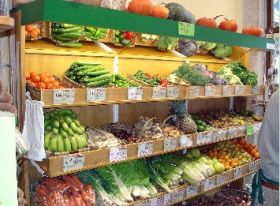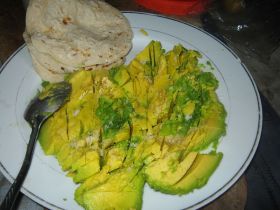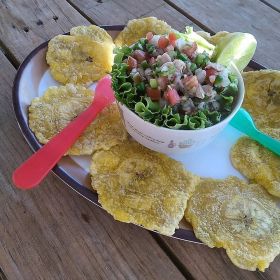How much does food cost in San Juan del Sur, Nicaragua?
Elaine Soto
The best way to describe San Juan del Sur's food cost is: variety. You can find lots of options when it comes to food, from cheap junk food to expensive gourmet plates. Even "expensive" food is not that expensive. You can eat a nice meal for less than $20 dollars but if what you want is just to calm your cravings and you're not that picky you can eat a hamburger, a burrito or a quesadilla in the main street for just US $1 to $1.50. San Juan del Sur...
The best way to describe San Juan del Sur's food cost is: variety. You can find lots of options when it comes to food, from cheap junk food to expensive gourmet plates. Even "expensive" food is not that expensive. You can eat a nice meal for less than $20 dollars but if what you want is just to calm your cravings and you're not that picky you can eat a hamburger, a burrito or a quesadilla in the main street for just US $1 to $1.50. San Juan del Sur is great not just for its gorgeous beach but also for its affordable prices.
Posted April 8, 2014
Daniel Snider - Snider's Realty Nicaragua
 The food in the markets in San Juan del Sur is very affordable, which it has to be for the common Nicaraguan. The cost of produce is much cheaper than it is in the US and so is the cost of meat, chicken or sausages. We buy roasted chicken just like you would in a lot of major supermarkets in the US. Out here roasted chicken costs about US $5 for a whole rotisserie chicken.
The food in the markets in San Juan del Sur is very affordable, which it has to be for the common Nicaraguan. The cost of produce is much cheaper than it is in the US and so is the cost of meat, chicken or sausages. We buy roasted chicken just like you would in a lot of major supermarkets in the US. Out here roasted chicken costs about US $5 for a whole rotisserie chicken. A dozen eggs is about $2.50, a loaf of bread is about $2 to $3, a dozen bananas is...
 The food in the markets in San Juan del Sur is very affordable, which it has to be for the common Nicaraguan. The cost of produce is much cheaper than it is in the US and so is the cost of meat, chicken or sausages. We buy roasted chicken just like you would in a lot of major supermarkets in the US. Out here roasted chicken costs about US $5 for a whole rotisserie chicken.
The food in the markets in San Juan del Sur is very affordable, which it has to be for the common Nicaraguan. The cost of produce is much cheaper than it is in the US and so is the cost of meat, chicken or sausages. We buy roasted chicken just like you would in a lot of major supermarkets in the US. Out here roasted chicken costs about US $5 for a whole rotisserie chicken. A dozen eggs is about $2.50, a loaf of bread is about $2 to $3, a dozen bananas is about $.60.
Fresh produce is very cheap, too. Fresh produce would probably be 20% to 40% cheaper than it is in the US since most of these are locally grown. Common fresh produce here in San Juan Del Sur are mostly citrus fruits like oranges, lime, and lemon. Tropical fruits like the Maracuya (Passion Fruit), Star Fruit, Dragon Fruit are also widely available here. Star Fruit costs about $2 per dozen.
Posted September 11, 2014
Diony Fuentes
Food in San Juan Del Sur is mostly affordable. It only tends to cost a little more if there are tourists in the area. Here are some common prices, in US dollars:
- A dozen eggs are $2
- Nicaraguan beer is $.99
- Milk is sold in bags. 1 liter of milk (about a quart) is $.75
- A loaf of bread is $1.35.
- A pound of chicken is around $2
- A pound of beef is $3.
- A pound of pork is 2.50.
- Fish in the market is about $3 to $4...
Food in San Juan Del Sur is mostly affordable. It only tends to cost a little more if there are tourists in the area. Here are some common prices, in US dollars:
- A dozen eggs are $2
- Nicaraguan beer is $.99
- Milk is sold in bags. 1 liter of milk (about a quart) is $.75
- A loaf of bread is $1.35.
- A pound of chicken is around $2
- A pound of beef is $3.
- A pound of pork is 2.50.
- Fish in the market is about $3 to $4 per pound but you can get it at a cheaper price if you buy fish by the beach directly from the fishermen who just came in. They sell fish for about $1 to $2 per pound.
Posted September 12, 2014
David Smith - Nicaragua Sotheby's International Realty
 I am budgeting about US $300 a month for my food here in San Juan Del Sur, which includes eating out a couple of times a week. It is very affordable once you get familiar with the actual Nica economy versus the expat economy. You can pick up fresh produce at the open-air market very economically and affordably. If you eat the non-imported, locally-grown, and locally-sourced food, it’s going to be significantly less expensive, but if you want your particular brand of...
I am budgeting about US $300 a month for my food here in San Juan Del Sur, which includes eating out a couple of times a week. It is very affordable once you get familiar with the actual Nica economy versus the expat economy. You can pick up fresh produce at the open-air market very economically and affordably. If you eat the non-imported, locally-grown, and locally-sourced food, it’s going to be significantly less expensive, but if you want your particular brand of... I am budgeting about US $300 a month for my food here in San Juan Del Sur, which includes eating out a couple of times a week. It is very affordable once you get familiar with the actual Nica economy versus the expat economy. You can pick up fresh produce at the open-air market very economically and affordably. If you eat the non-imported, locally-grown, and locally-sourced food, it’s going to be significantly less expensive, but if you want your particular brand of cheese, you are going to pay the same as you would in North America or more.
I am budgeting about US $300 a month for my food here in San Juan Del Sur, which includes eating out a couple of times a week. It is very affordable once you get familiar with the actual Nica economy versus the expat economy. You can pick up fresh produce at the open-air market very economically and affordably. If you eat the non-imported, locally-grown, and locally-sourced food, it’s going to be significantly less expensive, but if you want your particular brand of cheese, you are going to pay the same as you would in North America or more. There is also Pali, which is a very First World style grocery store here in San Juan Del Sur. It is like a small North American grocery store and it is where you can get pretty much everything you need. It is slightly more expensive to shop there but a lot of expats do. A budget of $200 to $300 per month per person on food would be fine, plenty enough. For a couple, the budget for food per month could be around $400.
I am budgeting what I do and I have seen other budgets for couples that are about the same. I entertain a lot and I am a couple half the time, so I am using what I budget but I probably use about the same as a couple would.
You can get your fresh fish right down on the beach where they bring it in every day. You buy the whole fish. That is how you buy fish here in San Juan Del Sur. They filet it but they filet it as a whole. We paid $8 for a huge fish, which would be a lot less than what we pay for in Toronto, Canada where I come from.
There is a place in town for North American style cheeses and meats that is quite expensive and that is sort of what we as expats buy for special treats. There is also Pan de Vida, which is a lovely type of bread in Nicaragua. It is expensive, but one of the things that you will find about Nicaragua is that the bread is not great by North American standards. There is a North American brick oven for bread making called Pan de Vida and they have a whole selection of fresh breads and pastries that they make every single day. It is very very popular. A loaf of bread would cost you about $4 or $5. It is quite expensive, but it has really good quality breads and cinnamon buns.
Our overall food cost here in San Juan Del Sur is about half of what it is if we were in Toronto. And that is eating not like a native Nicaraguan, but not like you would in Toronto, either. It is about midway. I really like lots of the fruits and produce in Nicaragua. You have to be careful buying food at one time and storing it in the fridge because when the power goes out, so does your fridge. You don’t want to be wasting food. So you have to be careful in not loading up your fridge. If you buy more fresh food frequently, it brings your budget down. It is very convenient to buy food almost every day since San Juan Del Sur is such a small town. I buy food nearly every day here.
Posted March 11, 2015
Daniel Bolanos - Hacienda & Ecolodge Morgan´s Rock
 In order to buy food in San Juan del Sur, you can go to “markets” as in “supermarkets in the States” or you can go to Nicaraguan open-air markets where you have the vendors in front of you with fruits and vegetables that they present to you to try to hook you in buying them. The open-air market has small stands outside, which are arranged by color. Then they have another side, where they have some non-food products.
In order to buy food in San Juan del Sur, you can go to “markets” as in “supermarkets in the States” or you can go to Nicaraguan open-air markets where you have the vendors in front of you with fruits and vegetables that they present to you to try to hook you in buying them. The open-air market has small stands outside, which are arranged by color. Then they have another side, where they have some non-food products. If I were to...
 In order to buy food in San Juan del Sur, you can go to “markets” as in “supermarkets in the States” or you can go to Nicaraguan open-air markets where you have the vendors in front of you with fruits and vegetables that they present to you to try to hook you in buying them. The open-air market has small stands outside, which are arranged by color. Then they have another side, where they have some non-food products.
In order to buy food in San Juan del Sur, you can go to “markets” as in “supermarkets in the States” or you can go to Nicaraguan open-air markets where you have the vendors in front of you with fruits and vegetables that they present to you to try to hook you in buying them. The open-air market has small stands outside, which are arranged by color. Then they have another side, where they have some non-food products. If I were to compare the food cost in the markets in San Juan Del Sur to the cost of food in the markets in Florida, it is much cheaper in San Juan Del Sur. The exchange rate right now is pretty much 27 Nicaraguan Cordobas to US $1. If you go to the Nicaraguan open-air market and buy rice, one pound is 15 Cordobas, which is about 60 cents. A pound of beans is 35 Cordobas, which is US $1.30. A pound of tomatoes is around 20 Cordobas, which is less than 75 cents.
If you go to the open markets, you will mainly get vegetables and fruits, but if you need some condiments and other things, then you have can go to the supermarkets, which are similar to American–style supermarkets, where you can get anything and everything you can get in the US. You might not get the same brands that you would get in an American supermarket, but you will find the product and other recognized brands.
Even the supermarkets here are still cheaper comparing to how much they are in US supermarkets. I go to PriceSmart, which is like Costco. I only buy fruits and some vegetables in the open-air market. I buy meats and condiments at PriceSmart. Some people buy from fishermen when they come in, which is possible, but I do not normally do that in the normal course of things. I have purchased directly from the fishermen, but not often.
( A typical Nicaraguan meal of avocado, lemon and tortilla, pictured.)
Posted March 14, 2015
Gordon MacKay - InNicaNow.com
 A dozen bananas in San Juan del Sur costs 15 córdobas ($0.50,) a pineapple costs $1, and watermelons cost just over a dollar each. Eggs cost about 4 córdobas ($0.13,) while a boneless, skinless chicken breast costs 65 córdobas ($2.20) a pound.
A dozen bananas in San Juan del Sur costs 15 córdobas ($0.50,) a pineapple costs $1, and watermelons cost just over a dollar each. Eggs cost about 4 córdobas ($0.13,) while a boneless, skinless chicken breast costs 65 córdobas ($2.20) a pound. Some fruits and vegetables are seasonal. For example, mangoes are very inexpensive right now because they’re in season. A very large mango that when once cut up will fill a whole bowl...
 A dozen bananas in San Juan del Sur costs 15 córdobas ($0.50,) a pineapple costs $1, and watermelons cost just over a dollar each. Eggs cost about 4 córdobas ($0.13,) while a boneless, skinless chicken breast costs 65 córdobas ($2.20) a pound.
A dozen bananas in San Juan del Sur costs 15 córdobas ($0.50,) a pineapple costs $1, and watermelons cost just over a dollar each. Eggs cost about 4 córdobas ($0.13,) while a boneless, skinless chicken breast costs 65 córdobas ($2.20) a pound. Some fruits and vegetables are seasonal. For example, mangoes are very inexpensive right now because they’re in season. A very large mango that when once cut up will fill a whole bowl costs only about $0.70.
If I spend $10 in the market in San Juan del Sur, I end up with two big bags of fruits and vegetables that if I carry around, would get me really good biceps. Mainly, we shop at the fruit and vegetable market for most of our food then go down to the butcher shop to get meat, and then maybe down to the fish market to get fish. We go grab a couple of things at the specialty shop like flavors and spices. My family and I eat mostly local produce.
(Ceviche, fish "cooked" in lime juice and fried plantains, San Juan del Sur, Nicaragua, pictured.)
Posted May 19, 2017


